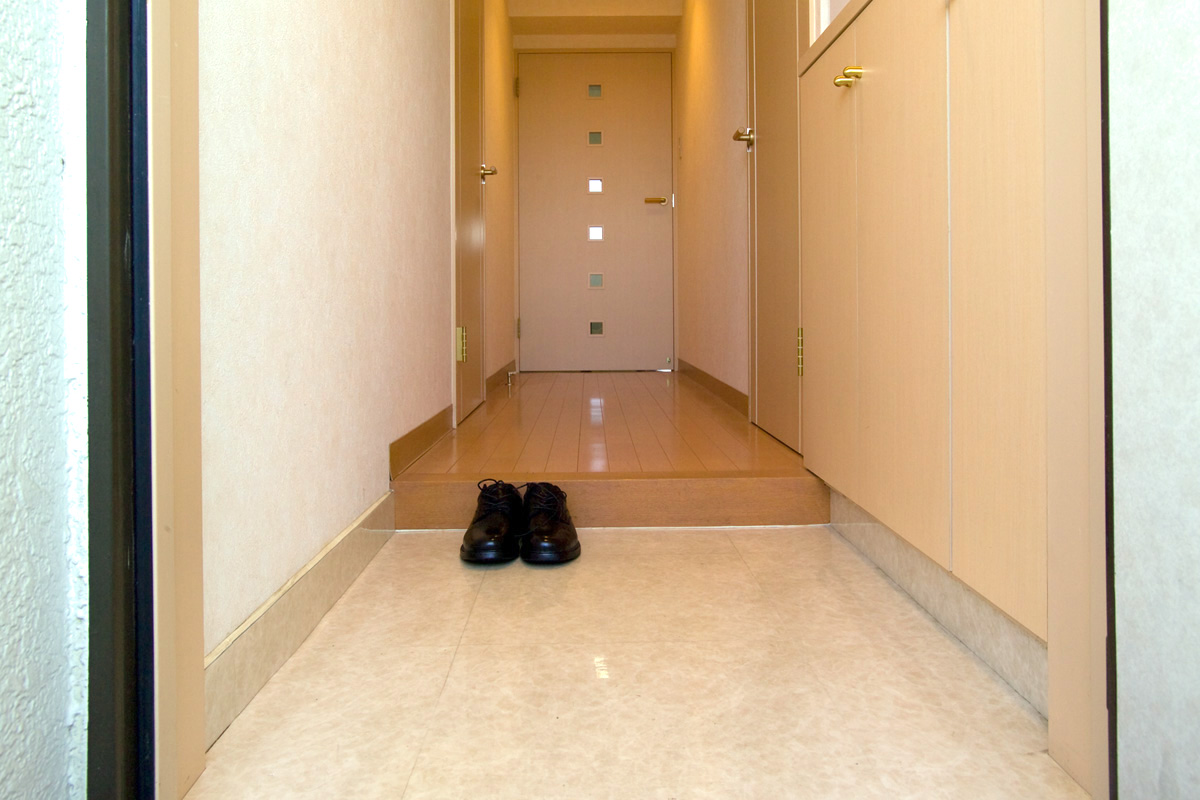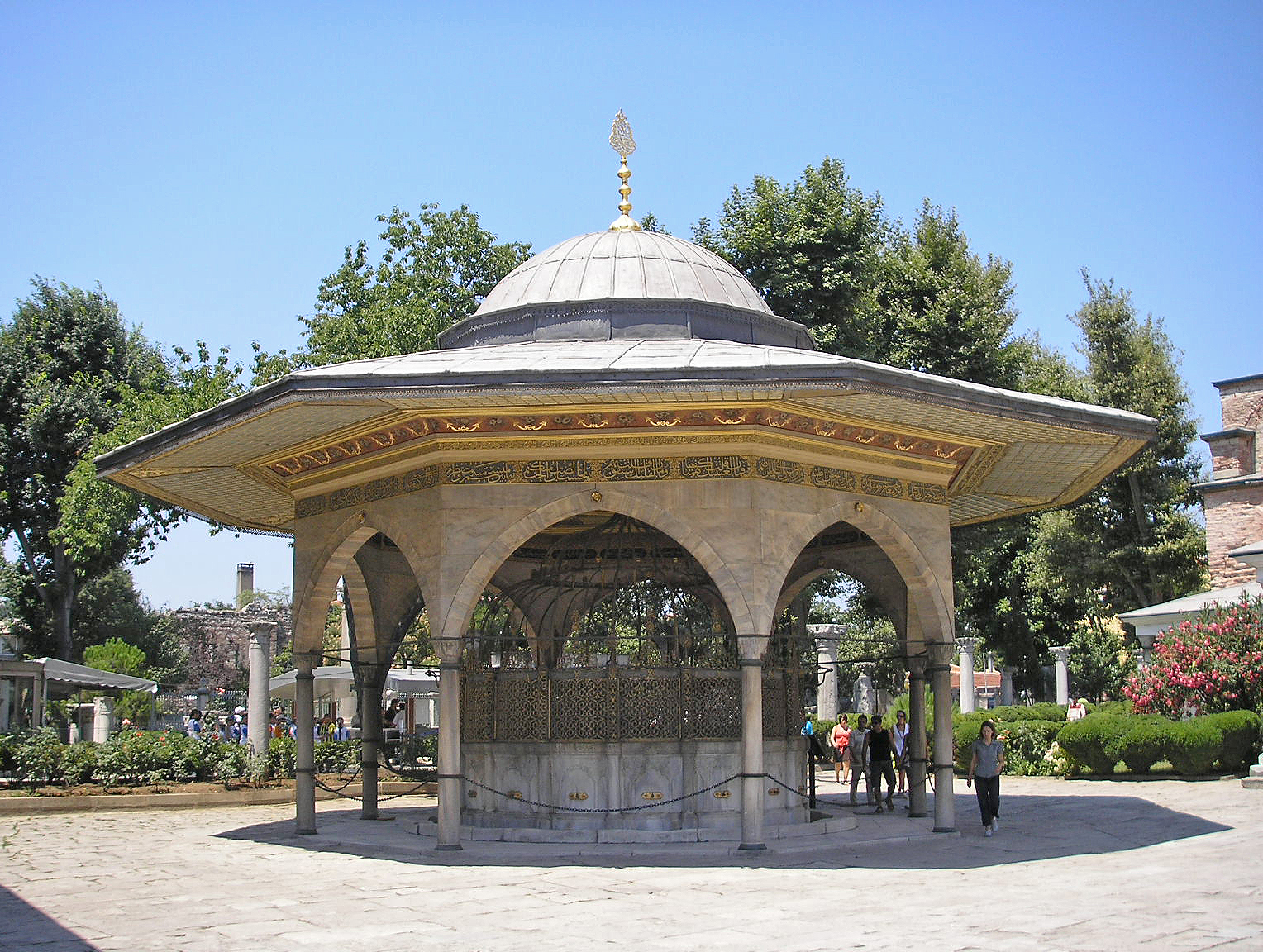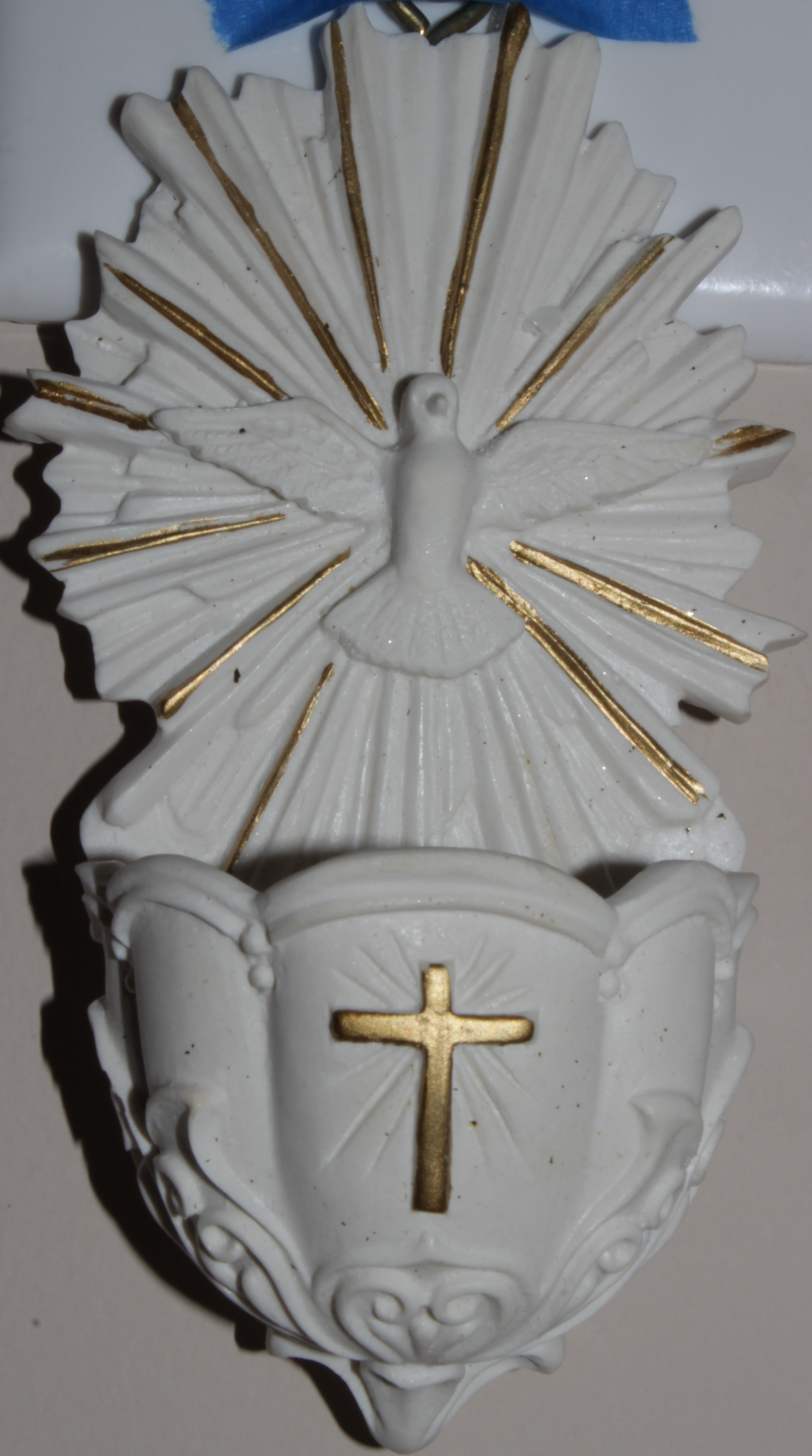|
Cantharus (Christianity)
A cantharus, also known as a phiala, is a fountain used by Christians for ablution before entering a church. These ablutions involve the washing of the hands, face, and feet. The cantharus is traditionally located in the exonarthex of the church. The water emitted by a cantharus is to be running water. The practice of ablutions before prayer and worship in Christianity symbolizes "separation from sins of the spirit and surrender to the Lord." Eusebius recorded this practice of canthari located in the courtyards of churches, for the faithful to wash themselves before entering a Christian house of worship. The practice has its origins Jewish practice of performing ablutions before entering into the presence of God (cf. ). Though canthari are not as prevalent anymore in Western Christianity, they are found in Eastern Christian and Oriental Christian churches. Gallery Famous canthari found throughout Christendom: File:Arabic fountain Monreale93.jpg, Cantharus of Monreale Cathedra ... [...More Info...] [...Related Items...] OR: [Wikipedia] [Google] [Baidu] |
Pamplona - Catedral, Claustro, Lavatorio
Pamplona (; eu, Iruña or ), historically also known as Pampeluna in English, is the capital city of the Navarre, Chartered Community of Navarre, in Spain. It is also the third-largest city in the greater Basque Country (greater region), Basque cultural region. Lying at near above sea level, the city (and the wider Cuenca de Pamplona) is located on the flood plain of the Arga river, a second-order tributary of the Ebro. Precipitation-wise, it is located in a transitional location between the rainy Atlantic northern façade of the Iberian Peninsula and its drier inland. Early population in the settlement traces back to the late Bronze to early Iron Age, even if the traditional inception date refers to the foundation of by Pompey during the Sertorian Wars circa 75 BCE. During Visigothic Kingdom, Visigothic rule Pamplona became an episcopal see, serving as a staging ground for the Christianization of the area. It later became one of the capitals of the Kingdom of Navarre, Kingdo ... [...More Info...] [...Related Items...] OR: [Wikipedia] [Google] [Baidu] |
Great Lavra
The Monastery of Great Lavra ( el, Μονή Μεγίστης Λαύρας) is the first monastery built on Mount Athos. It is located on the southeastern foot of the Mount at an elevation of . The founding of the monastery in AD 963 by Athanasius the Athonite marks the beginning of the organized monastic life at Mount Athos. At the location of the monastery, there was one of the ancient cities of the Athos peninsula, perhaps Akrothooi, from which the sarcophagi of the monastery that are in the oil storage house come. The history of the monastery is the most complete compared to the history of the other monasteries, because its historical archives were preserved almost intact. It is possible that the study of these archives may contribute to the completion of the knowledge of the history of other monasteries, whose archives were partially or completely lost. Founding The founder of Great Lavra, Athanasius, began the construction of the buildings in 963, according to the will of hi ... [...More Info...] [...Related Items...] OR: [Wikipedia] [Google] [Baidu] |
Hygiene
Hygiene is a series of practices performed to preserve health. According to the World Health Organization (WHO), "Hygiene refers to conditions and practices that help to maintain health and prevent the spread of diseases." Personal hygiene refers to maintaining the body's cleanliness. Hygiene activities can be grouped into the following: home and everyday hygiene, personal hygiene, medical hygiene, sleep hygiene and food hygiene. Home and every day hygiene includes hand washing, respiratory hygiene, food hygiene at home, hygiene in the kitchen, hygiene in the bathroom, laundry hygiene and medical hygiene at home. Many people equate hygiene with 'cleanliness,' but hygiene is a broad term. It includes such personal habit choices as how frequently to take a shower or bath, wash hands, trim fingernails, and wash clothes. It also includes attention to keeping surfaces in the home and workplace clean, including bathroom facilities. Some regular hygiene practices may be considered good ... [...More Info...] [...Related Items...] OR: [Wikipedia] [Google] [Baidu] |
Ritual Purity In Christianity
In Christianity, ablution is a prescribed washing of part or all of the body or possessions, such as clothing or ceremonial objects, with the intent of purification or dedication. In Christianity, both baptism and footwashing are forms of ablution. Prior to praying the canonical hours at seven fixed prayer times, Oriental Orthodox Christians wash their hands and face (cf. ''Agpeya'', ''Shehimo''). In liturgical churches, ablution can refer to purifying fingers or vessels related to the Eucharist. In the New Testament, washing also occurs in reference to rites of Judaism part of the action of a healing by Jesus, the preparation of a body for burial, the washing of nets by fishermen, a person's personal washing of the face to appear in public, the cleansing of an injured person's wounds, Pontius Pilate's washing of his hands as a symbolic claim of innocence and foot washing, which is a rite within the Christian Churches. According to the Gospel of Matthew, Pontius Pilate declared ... [...More Info...] [...Related Items...] OR: [Wikipedia] [Google] [Baidu] |
Tradition Of Removing Shoes In The Home And Houses Of Worship
In many cultures, there is a tradition of removing one's shoes in the home and places such as churches, temples and schools. Backgrounds In religions originating in the Indian subcontinent and in the Middle East, it is customary to remove one's shoes when entering a house of worship. In the Bible, God commanded Moses to remove his sandals before approaching Him on Mount Sinai (cf. ). The cultural context of this narrative regards shoes as bringing in dust into the home and removing one's shoes "would be a way of recognizing one's personal uncleanness in the presence of holiness." Hinduism and Islam also regard feet as being unclean; it is considered sacrilegious to touch books with one's feet and an insult to point one's feet at someone. As such, in many mandirs and mosques, as well as in churches and synagogues of the Indian subcontinent and Middle East, it is customary for worshippers to remove their shoes before entering a house of worship, where they believe they are enteri ... [...More Info...] [...Related Items...] OR: [Wikipedia] [Google] [Baidu] |
Shadirvan
A shadirvan ( fa, شادروان, tr, şadırvan, ar, شاذروان) is a type of fountain that is usually built in the courtyard or near the entrance of mosques, caravanserais, khanqahs, and madrasas, with the main purpose of providing water for drinking or ritual ablutions to several people at the same time, but also as decorative visual or sound elements. Shadirvan are Persian in origin and, with a curtain or drape, were originally placed in the tents of rulers or on the balconies of palaces. They are a typical element of Ottoman architecture. See also * Cantharus, a similar fountain in Christian places of worship * Howz In traditional Persian architecture, a howz ( fa, حوض) is a centrally positioned symmetrical axis pool. If in a traditional house or private courtyard, it is used for bathing, aesthetics or both. If in a sahn of a mosque, it is used for pe ... * Sebil or sabil, public water fountain in Islamic countries References External links {{A ... [...More Info...] [...Related Items...] OR: [Wikipedia] [Google] [Baidu] |
Sebil (fountain)
A sebil or sabil ( ar, سبيل, sabīl ; Turkish: ''sebil'') is a small kiosk in the Islamic architectural tradition where water is freely dispensed to members of the public by an attendant behind a grilled window. The term is sometimes also used to refer to simple unmanned fountains with a tap for drinking water, though other names often exist for such fountains (such as ''çesme'' in Turkish). Historically, sebils are structures of both civic and religious importance in Muslim cities, most prominently in the cities of the Ottoman Empire, based in Istanbul, and of the Mamluk Empire, based in Cairo. They were built at crossroads, in the middle of city squares, and on the outside of mosques and other religious complexes to provide drinking water for travelers and to assist ritual purification (ablutions) before prayer. Etymology The word ''sebil'' or ''sabil'' comes from the Arabic verb root ''sabala'' (سبل) meaning "to let fall, drop, to let hang down, to close eyes ... [...More Info...] [...Related Items...] OR: [Wikipedia] [Google] [Baidu] |
Maundy (foot Washing)
Maundy (from Old French ''mandé'', from Latin ''mandatum'' meaning "command"), or Washing of the Saints' Feet, Washing of the Feet, or Pedelavium or Pedilavium, is a religious rite observed by various Christian denominations. The Latin word ''mandatum'' is the first word sung at the ceremony of the washing of the feet, "''Mandatum novum do vobis ut diligatis invicem sicut dilexi vos''", from the text of John 13:34 in the Vulgate ("I give you a new commandment, That ye love one another as I have loved you", ). This is also seen as referring to the commandment of Christ that believers should emulate his loving humility in the washing of the feet (). The term ''mandatum'' (''mandé'', maundy), therefore, was applied to the rite of foot-washing on the Thursday preceding Easter Sunday, called Maundy Thursday. John 13:2–17 recounts Jesus' performance of this action. In verses 13:14–17, He instructs His disciples: Footwashing was practiced by the early Church, prior to rece ... [...More Info...] [...Related Items...] OR: [Wikipedia] [Google] [Baidu] |
Lavatorium
A lavatorium (plural ''lavatoria''), also anglicisation, anglicised as laver and lavatory, was the communal washing area in a monastery, particularly in medieval abbeys and cathedral cloisters. Monks were required to wash before meals; thus the lavatorium was typically adjacent to the refectory. Description All monastic orders required handwashing before meals. A lavatorium was therefore provided near the refectory, either against one wall of the cloister with a long trench basin, or as a free-standing building with a circular or octagonal basin in the centre. An example of the first type, dating to the 14th century, survives at Gloucester Cathedral, and has a towel cupboard nearby. At Durham Cathedral, the lavatorium was a square building with a circular basin which was replaced in 1432–33 with one of marble. At Wenlock Priory, the octagonal lavatorium, now ruined, was decorated with late-12th-century carved panels including one of Jesus with the apostles at the Sea of Gali ... [...More Info...] [...Related Items...] OR: [Wikipedia] [Google] [Baidu] |
Lavabo
A lavabo is a device used to provide water for the washing of hands. It consists normally of a ewer or container of some kind to pour water, and a bowl to catch the water as it falls off the hands. In ecclesiastical usage it refers to all of: the basin in which the priest washes their hands; the ritual that surrounds this action in the Catholic Mass; and the architectural feature or fitting where a basin or place for one is recessed into the side wall of the sanctuary, or projects from it. If this last includes or included a drain, it is a piscina used for washing the church plate and other fittings, though the terms are often confused. In secular usage, it is an obsolete term for any sink or basin for washing hands, especially in a lavatory. Ablutions before Christian prayer and worship Churches from the time of Constantine the Great were built with an exonarthex that included a fountain known as a cantharus, where Christians would wash their hands, face and feet before enteri ... [...More Info...] [...Related Items...] OR: [Wikipedia] [Google] [Baidu] |
Hygiene In Christianity
In certain denominations of Christianity, hygiene in Christianity includes a number of regulations involving cleanliness before prayer, as well as those concerning diet and apparel. History The Bible has many rituals of purification relating to menstruation, childbirth, sexual relations, nocturnal emission, unusual bodily fluids, skin disease, death, and animal sacrifices. In the Old Testament, ablution was considered a prerequisite to approaching God, whether by means of sacrifice, prayer, or entering a holy place. Christianity has always placed a strong emphasis on hygiene. Water plays a role in the Christian rituals. A major contribution of the Christian missionaries in Africa, China, Guatemala, India, Indonesia, Korea, and other places was better health care of the people through hygiene and introducing and distributing the soaps, and "cleanliness and hygiene became an important marker of being identified as a Christian". Early Christian clergy condemned the pr ... [...More Info...] [...Related Items...] OR: [Wikipedia] [Google] [Baidu] |
Home Stoup
A home stoup is a small stoup with a small bowl and a decorated plaque that Christians in the Roman Catholic, Anglican and Lutheran traditions, hang inside homes, either at the house's entrance or, more commonly, on a bedroom wall at the head of the bed.Henri Chaperon: ''Le bénitier de Chevet'' (1991) Éditions Varia Sometime a small blessed branch of boxwood is placed behind the stoup, or they hang a rosary on the stoup.In many liturgical Christian denominations, palm fronds or piece of buxus are blessed on Palm Sunday and kept by the people all the year round. The small bowl contains holy water so that the house's inhabitants could cross themselves in the morning and make the sign of the cross over their beds at night. The use of these stoups began in the earliest centuries of the Christian Church. They were made of both expensive (gold, silver, etc.) and cheap (faience, ceramic, wood) materials; dependent on the fortunes of their owners. They were handmade with a painting or r ... [...More Info...] [...Related Items...] OR: [Wikipedia] [Google] [Baidu] |







_02_by_shakko.jpg)

